|
TennisOne Lessons


Improving the Second Serve
Dave Kensler - Peter Burwash International (PBI)
Is there any shot in tennis which consistently causes more nervousness and physical tightness than having to hit a second serve?
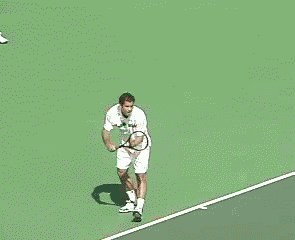 Pete Sampras - with upwards of 5,000 rpm, perhaps the best second serve in the history of the game.
Pete Sampras - with upwards of 5,000 rpm, perhaps the best second serve in the history of the game. |
Pick any key point during a match and most tennis players will be more nervous on the second serve than on any other shot. In fact, I cannot ever recall one of my students telling me, “I get very nervous returning serve in a close match.” However, I do hear all the time, “When a match gets tight, I get tense and nervous when serving and particularly with my second serve.”
With this article I will share some tips, ideas and drills you can implement to increase your confidence in your second serve. After all, there is some truth to the time honored phrase, “You are only as good a player as your second serve.” Nobody gets their first serve in all the time. Therefore, your ability to execute a solid game plan is going to come down to how well you hit your second serve.
Let us begin by looking at the overall situation.
Problems with the Second Serve
If I had to pick one “theme” I have observed over the years it would be that too often, the first serve looks very different from the second serve. In virtually every facet of the stroke; the motion, the ball toss, the swing speed, the type of serve hit, and so on, the second serve looks different. It is as if the person is hitting two completely different serves.
We have all seen the player who has a full wind-up on the first serve and blasts it; then on the second serve he/she uses an abbreviated motion and simply “pushes” the ball into play relying on gravity to bring it down into the service box. Yet when I watch Roger Federer or any of the pros for that matter, the first and second serves look more similar than they do different. Would you take two completely different swings on your forehand ground stroke on a similar ball hit to you?
Interestingly, when I watch people practice their serve, rarely do I see them work on their second one. The motion I observe is usually the one they use for their first serve.
How to Hit Your Second Serve
I believe a good starting point is a mental one and along the lines of what I
just alluded to above. Think of your first and second serves as more similar
than different. Once you do this, there will be more common denominators
between the two. Then it makes the technical aspects easier. Let us take
a look at them.
Feet Position
As Jim McLennan noted in his article, Australian Open - All About the Second Serve, keeping the feet still during the second serve promotes better balance. Any time you are executing an upper body motion like that, it helps to stabilize the feet. Think of a pro football quarterback, would he rather pass while running or when he has a chance to plant his feet?
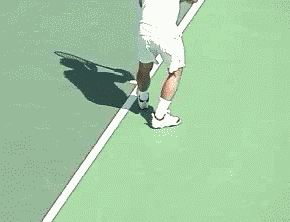 Keeping the feet still during the second serve promotes better balance.
Keeping the feet still during the second serve promotes better balance. |
I often see players with a lot of lower body movement on their second serve and I know immediately they are going to have problems under pressure. Because we are naturally more tight on the second serve any way; add to that, extra lower body movement and the end result is a very tense serve.
Note that stabilizing the feet does not preclude bending the knees or arching your back if that is what you prefer, It means simply keeping the feet still.
Racquet Starting Point
I always advocate starting the serve by supporting the racquet head with the ball tossing hand in some form or fashion. If for no other reason than it allows you to relax your hitting hand on the grip. I also feel it helps with the timing of your motion by having the ball tossing hand and racquet hand begin from the same area. However, the key point again is that whatever you do on your first serve (Assuming you comfortable with it), try to repeat when hitting a second serve.
Ball Toss
Simply because of the situation, the second serve ball toss is often going to be lower than the first serve toss. This is because we are often more nervous and tighter on the second serve. When you are physically tense, the natural tendency is to toss the ball lower. If the ball toss is too low; however, you will not build up very much racquet head speed when striking the ball. The less racquet head speed, the less pace, spin, and most likely depth on the second serve.
You may intentionally toss the ball in a different location for your second serve because you want to hit a specific type of serve (slice or kick). This is fine but remember, if you are having problems with your second serve you may wish to experiment by making your first and second serve ball tosses more similar. Try it and see if it works.
 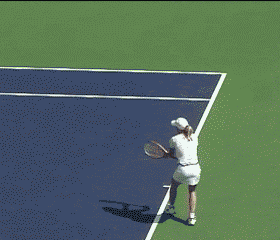 There is very little difference in Justine Hennin's ball toss and motion on her first (left)
There is very little difference in Justine Hennin's ball toss and motion on her first (left)
and second serves. |
Grip(s)
The grip is another aspect of the serve that many club players have difficulty with and it is one of the major reasons so many club players have trouble hitting an effective second serve. As we know, in general, grips can enhance the ability to hit the ball a certain way and they can also create limitations. The serve is no different than other strokes. The more extreme the grip the more the limitations.
For example, if you rotate your hand to a severe eastern backhand grip, you probably will create lots of spin but the power and depth is going to be relatively weak. Moving in the other direction, if you rotate your hand towards an eastern forehand or further (semi-western) then your serve will be flatter and perhaps with some power but it will severely limit your ability to add spin. Without spin, bringing a hard hit serve down inside the serving area becomes somewhat problematic.
Therefore, a grip somewhere in the realm of a continental one is going to allow you the greatest flexibility and the best balance between spin and pace. With this grip you can hit a variety of serves while maintaining a good comfort level.
The Point of Contact
In addition to issues like the stance, grips, ball toss, types of serves and others, there is also the need to address what should happen at the point of contact. By point of contact, I am not talking about where to contact the ball but rather how to “influence” the moment in the serve when the ball and strings meet. This is where your ability to use your hand/wrist becomes important. One reason I often suggest the wrist for this portion of the serve is that it allows someone to keep the same overall motion and rhythm whether hitting a first or second serve. The variable in the shot becomes the wrist. For a first serve I may, as one example, accelerate the wrist faster for more power than on the second one; otherwise, almost everything else is the same.
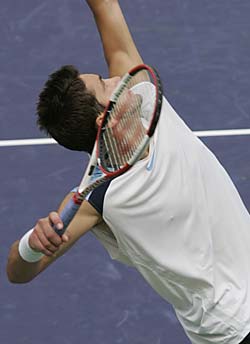 The continental allows for the greatest flexibility and the best balance between
The continental allows for the greatest flexibility and the best balance between
spin and pace. |
By keeping as much of the overall service motion similar between first and second serves, the wrist can be utilized not just for power but also direction, depth, and spin. It also becomes the key factor for correcting mistakes, ”Hit up” emphasizing the wrist to correct a previous service error into the net or a serve which went it but not very deep. “Snap down” emphasizing the wrist to correct a previous serve which was long. Many club players try to make adjustments with their arm and/or body which ultimately changes their motion.
Obviously no two serves are going to be identical whether it is your first or second serve; however, if you can reduce the variables between your first and second serve then will increase your chances for success.
A great analogy of the value of the wrist in serving is throwing a ball. Can you throw a ball further, with better speed, depth, and direction if your hand is squeezing the ball hard or if the hand and wrist is relaxed? When I ask players to throw a ball, they seem relaxed from their shoulders to their fingertips. Yet, hand these same players a racquet and there is literally liquid graphite dripping out the bottom of the handle because they are squeezing so tightly! Then they wonder why they have problems with their serves?!
In the previous section I wrote about grips. The type of grip you use will have a direct impact on how effectively you can use your wrist. The more extreme your grip the more limiting your ability to use the wrist. For example, if you want to hit a “kick serve,” using an eastern forehand grip will severely limit your ability to accomplish that goal. It is very difficult to impart enough spin on the ball serving with an eastern grip. The eastern forehand service grip has a more natural tendency to create a flat serve than it does heavy spin.
When you are looking at the technical aspects of improving your second serve, serious consideration may need to be given to the type of grip you are using as it relates to the desired result. Grip changes can be daunting for many people but any teaching pro can help you through the transition. Otherwise, if you are content using, say an eastern forehand grip for both your first and second serves, simply recognize the limitations you will have in adding spin and maximizing the use of your wrist.
Have a plan
Too often tennis players have a specific plan or goal with their first serve i.e. “I am going to serve it flat and hard to their backhand.” However, when it comes to their second serve, the thought process is reduced to simply “get it in.” Make your second serve plan more proactive and aggressive i.e. “I am going to hit a slice serve deep and into the body.” Remember, thinking more aggressively does not mean you have to hit the ball harder.
Bring The First And Second Serve “Closer Together”
One of the greatest differences I see in tennis players is the speed of the first serve compared to the second one. A first serve will come in at 80 mph and the second at 20 mph. When I see this much discrepancy, I know the person will have trouble or at the very least be tight with the second serve in a close match. The other problem with those types of second serves is while they may be consistent; there is nothing about them which could present a challenge to an opponent.
I often say to my students, “Lets try slowing down your first serve a little bit and adding more speed to your second one.” So instead of say a 80 / 20 split in speed; maybe it becomes 65 / 35.
If you do not have a consistent first serve which blasts people off the court, then why continue to expend all that energy hitting it? Slow it down some and perhaps increase your consistency while at the same time adding pop to your second serve. Bring them closer together. Again, the key is in how you use the wrist. Keep your motion, ball toss, and arm speed the same. Just vary what you do with the wrist.
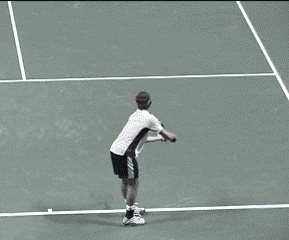 Flat serve? Even Andy Roddick, the biggest server in the game spins his serve at over 1,500 rpm.
Flat serve? Even Andy Roddick, the biggest server in the game spins his serve at over 1,500 rpm. |
Which Serve Is Best For You?
There are three types of serves which are commonly referred to, flat, slice, and kick or topspin. It is to your advantage to have as many options in your tennis game as possible. Therefore, it makes you a better player if you can hit all three, whether it be for your first or second serve.
As they apply to the second serve, let us take a look at the advantages an disadvantages of each.
Flat - This is a bit of a misnomer, since, on the ATP tour, even the flattest of first serves are spinning at well over 1,000 rpm. A flat serve is probably the least recommended for a second serve largely because of the low safety margin. The ball may clear the net by only one inch and still go long. However, sometimes if you are feeling a little tight, it might help to go ahead and hit a flat, well-paced second serve in hopes of loosening up a bit.
Slice - One of the great aspects about a slice is it works well for both first and second serves. The spin can help create some arc which aids in net clearance. The ball can either curve into an opponent or away from them, so even if it is not hit very hard or deep, there is still some offense to it. Physically it is not a very demanding stroke. It has more to do with how you strike the ball rather than how much effort you exert. The “slice” or “curve” is created by having the strings contact the “outside” of the ball as opposed to behind it like a flat serve.
Kick or Topspin - The kick serve is usually the second serve of choice for players on the pro tour in part because of its high net clearance and bounce. If hit aggressively, it can become an offensive shot. If you can make your opponent return a serve which bounces above shoulder level on the backhand side, it is difficult for them to do much with it. This is also a popular serve for doubles play because it “hangs” in the air longer and allows the server to get closer to the net.
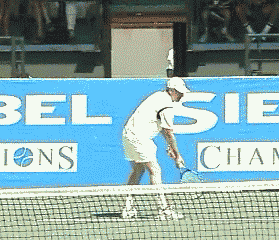 From the ad side, Mac's wicked left handed slice could pull opponents way off the court.
From the ad side, Mac's wicked left handed slice could pull opponents way off the court. |
The challenge for many players is that this serve can be very strenuous to hit, particularly on the back. In order to get the kick or bounce, the ball toss usually needs to be more above and even a little behind the head so you can bend your back in order get the racquet head in position to move in an upward fashion. Because of this motion, it is often easier for the opponent to “read” the serve as opposed to a slice or flat shot.
Practice the Disguise Factor
What happens frequently, even for those with a good second serve, is they telegraph what serve they are going to hit by their motion. They blast the first serve; then go into a back-bending motion to hit a “kick” second serve. The person returning knows what is going to happen before the serve is hit!
If you can hit a flat, slice, and even topspin serve all from the same basic motion / ball toss then you can add the element of “disguise,” making your serve that much more effective. Pete Sampras was a master of disguise. Opponents found it difficult to read where his serve was going or what kind of serve he was using. The next time you are watching a pro match, see if you can figure out what type of serve the player is going to hit and in what direction based on the motion and ball toss.
Improve Your Serve to the Ad Court?
In traditional scoring all the game points except one(40-15 / 15-40) are played to the ad court. In addition, the 30-15 / 15-30 point, arguably the most important non-game deciding point, is also played to the ad court. Since 85% of the population is right-handed there is a natural tendency for right-handed players to hit their serve more towards the higher part of the net on the ad court.
Therefore, your second serve (and first serve too) may need more net clearance capabilities than on the deuce court side. Again, referring to the scoring situations, in general, tennis players are going to feel more pressure when serving to the ad court.
How to Work On the Second Serve?
Most people grab a bucket of balls, run out to the court, and start practicing. The problem with serving from a basket of balls, however, is the lack of pressure. It is the pressure of a game situation which impacts the second serve more than any other factor. Serving from a basket of balls is great to work on technical aspects like spin, power, placement, depth, and so on, however, it does nothing to create the feel of a pressured match situation
The best approach to improving your second serve is to play a practice match using only one serve! Look at this way, you cannot blast away because if you miss you lose the point. On the other hand, you cannot dink your serve because your opponent knows you only have one serve and will quickly begin to move into a more aggressive court position to attack. So you are forced to hit a serve somewhere in between a rocket first serve and wimpy second serve. In other words, playing with only one serve best duplicates the pressure you face in normal game situations.
Go out and play a set with only one serve and then play a second set with the normal two serves and see if your second serve doesn't improve!
In addition, there are two other features of the one serve play which I like:
- The serve will be less of a determining factor in the points so it forces both players to win with their other shots.
- It is a great neutralizer if there are two players at different levels. The weaker player gets two serves; the stronger player gets only one serve.
Remember, confidence is a key factor in all sports. If you are confident with the technical aspects of your second serve, then you are well on your way to improving your overall tennis game!
Your comments are welcome. Let us know what you think about Dave Kensler's article by emailing us here at TennisOne.

Dave Kensler has 23 years of teaching experience with Peter Burwash International (PBI), the most successful international tennis management company.PBI directs tennis programs at 60+ exclusive resorts and clubs in 23 countries and has taught over 3 million students in their 30 year history. For information on PBI tennis destinations and employment opportunities please go to www.pbitennis.com.All PBI Tennis Professionals play with WILSON racquets and wear WILSON shoes.
|
|







